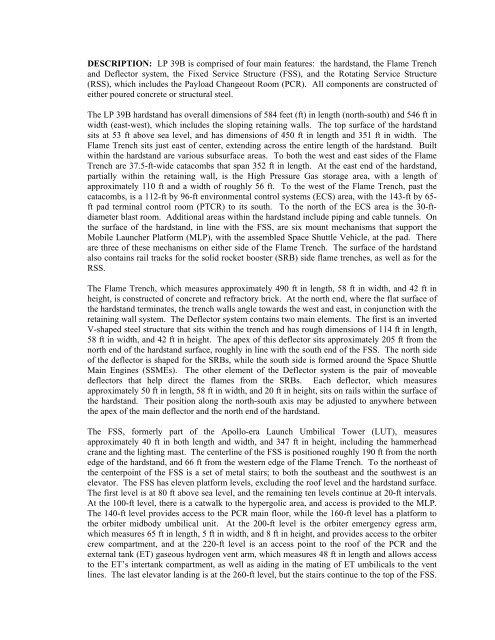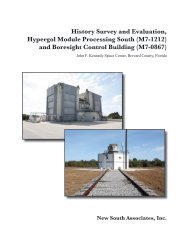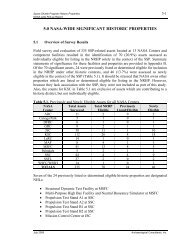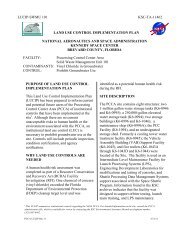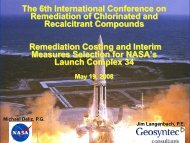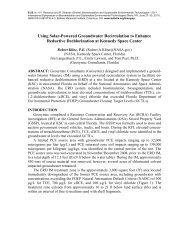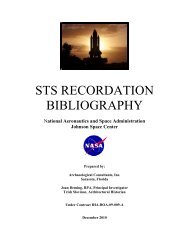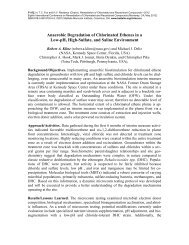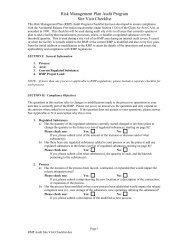john f. kennedy space center brevard county, florida - Environmental ...
john f. kennedy space center brevard county, florida - Environmental ...
john f. kennedy space center brevard county, florida - Environmental ...
You also want an ePaper? Increase the reach of your titles
YUMPU automatically turns print PDFs into web optimized ePapers that Google loves.
DESCRIPTION: LP 39B is comprised of four main features: the hardstand, the Flame Trench<br />
and Deflector system, the Fixed Service Structure (FSS), and the Rotating Service Structure<br />
(RSS), which includes the Payload Changeout Room (PCR). All components are constructed of<br />
either poured concrete or structural steel.<br />
The LP 39B hardstand has overall dimensions of 584 feet (ft) in length (north-south) and 546 ft in<br />
width (east-west), which includes the sloping retaining walls. The top surface of the hardstand<br />
sits at 53 ft above sea level, and has dimensions of 450 ft in length and 351 ft in width. The<br />
Flame Trench sits just east of <strong>center</strong>, extending across the entire length of the hardstand. Built<br />
within the hardstand are various subsurface areas. To both the west and east sides of the Flame<br />
Trench are 37.5-ft-wide catacombs that span 352 ft in length. At the east end of the hardstand,<br />
partially within the retaining wall, is the High Pressure Gas storage area, with a length of<br />
approximately 110 ft and a width of roughly 56 ft. To the west of the Flame Trench, past the<br />
catacombs, is a 112-ft by 96-ft environmental control systems (ECS) area, with the 143-ft by 65-<br />
ft pad terminal control room (PTCR) to its south. To the north of the ECS area is the 30-ftdiameter<br />
blast room. Additional areas within the hardstand include piping and cable tunnels. On<br />
the surface of the hardstand, in line with the FSS, are six mount mechanisms that support the<br />
Mobile Launcher Platform (MLP), with the assembled Space Shuttle Vehicle, at the pad. There<br />
are three of these mechanisms on either side of the Flame Trench. The surface of the hardstand<br />
also contains rail tracks for the solid rocket booster (SRB) side flame trenches, as well as for the<br />
RSS.<br />
The Flame Trench, which measures approximately 490 ft in length, 58 ft in width, and 42 ft in<br />
height, is constructed of concrete and refractory brick. At the north end, where the flat surface of<br />
the hardstand terminates, the trench walls angle towards the west and east, in conjunction with the<br />
retaining wall system. The Deflector system contains two main elements. The first is an inverted<br />
V-shaped steel structure that sits within the trench and has rough dimensions of 114 ft in length,<br />
58 ft in width, and 42 ft in height. The apex of this deflector sits approximately 205 ft from the<br />
north end of the hardstand surface, roughly in line with the south end of the FSS. The north side<br />
of the deflector is shaped for the SRBs, while the south side is formed around the Space Shuttle<br />
Main Engines (SSMEs). The other element of the Deflector system is the pair of moveable<br />
deflectors that help direct the flames from the SRBs. Each deflector, which measures<br />
approximately 50 ft in length, 58 ft in width, and 20 ft in height, sits on rails within the surface of<br />
the hardstand. Their position along the north-south axis may be adjusted to anywhere between<br />
the apex of the main deflector and the north end of the hardstand.<br />
The FSS, formerly part of the Apollo-era Launch Umbilical Tower (LUT), measures<br />
approximately 40 ft in both length and width, and 347 ft in height, including the hammerhead<br />
crane and the lighting mast. The <strong>center</strong>line of the FSS is positioned roughly 190 ft from the north<br />
edge of the hardstand, and 66 ft from the western edge of the Flame Trench. To the northeast of<br />
the <strong>center</strong>point of the FSS is a set of metal stairs; to both the southeast and the southwest is an<br />
elevator. The FSS has eleven platform levels, excluding the roof level and the hardstand surface.<br />
The first level is at 80 ft above sea level, and the remaining ten levels continue at 20-ft intervals.<br />
At the 100-ft level, there is a catwalk to the hypergolic area, and access is provided to the MLP.<br />
The 140-ft level provides access to the PCR main floor, while the 160-ft level has a platform to<br />
the orbiter midbody umbilical unit. At the 200-ft level is the orbiter emergency egress arm,<br />
which measures 65 ft in length, 5 ft in width, and 8 ft in height, and provides access to the orbiter<br />
crew compartment, and at the 220-ft level is an access point to the roof of the PCR and the<br />
external tank (ET) gaseous hydrogen vent arm, which measures 48 ft in length and allows access<br />
to the ET’s intertank compartment, as well as aiding in the mating of ET umbilicals to the vent<br />
lines. The last elevator landing is at the 260-ft level, but the stairs continue to the top of the FSS.


